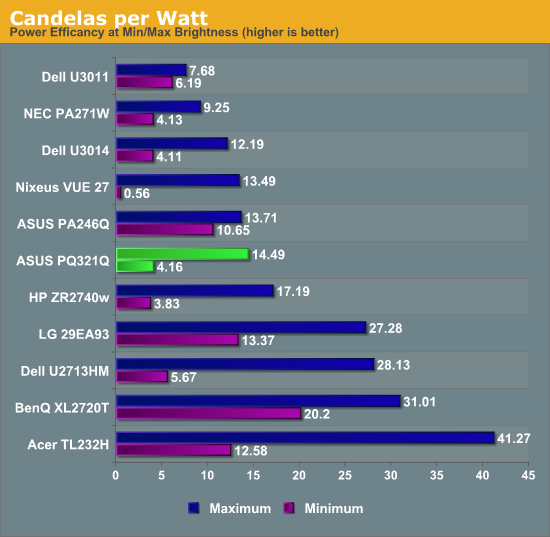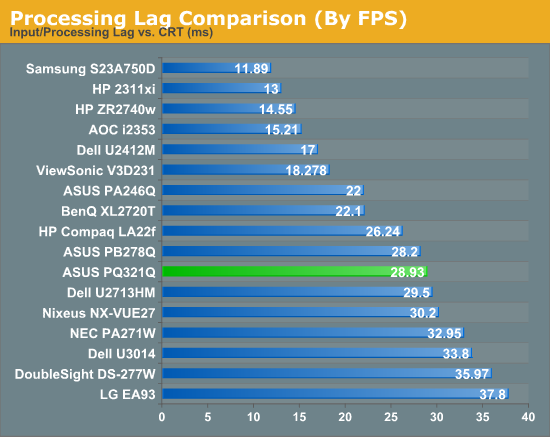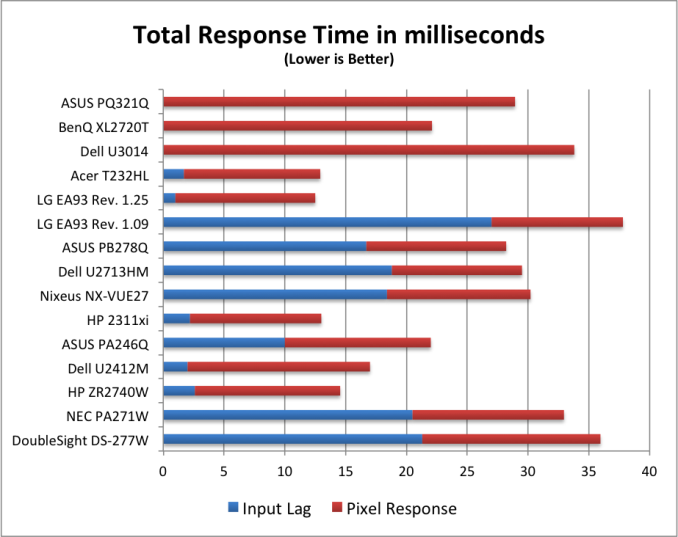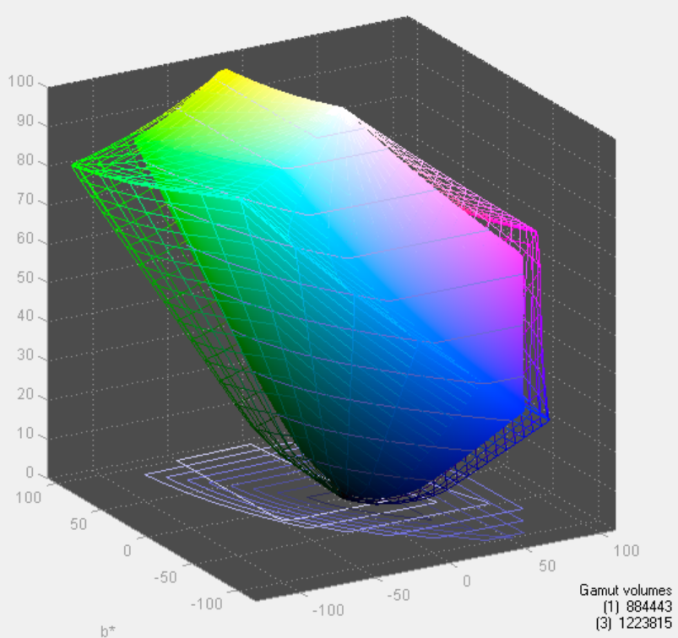ASUS PQ321Q UltraHD Monitor Review: Living with a 31.5-inch 4K Desktop Display
by Chris Heinonen on July 23, 2013 9:01 AM ESTUsing the updated metric for power usage, where I factor in maximum brightness and screen area and not just power usage, the ASUS PQ321Q falls right in the middle of the pack. For both maximum and minimum brightness it does OK but not incredible in comparison to other displays. With the greater transmission of IGZO I would have thought I might see better numbers from the ASUS, but I imagine power usage was very low on the list of concerns relative to other performance numbers.
Overall the ASUS PQ321Q draws a relatively average amount of power compared to other displays.


For testing input lag, I’m again reduced to using the Leo Bodnar lag tester over HDMI. This also means that the ASUS will have to scale the 1080p signal to be 2160p and fill the screen. Unlike before, I think this might be a more accurate test as many people will not be gaming at 2160p yet. Looking at the gaming numbers that our Ian Cutress found with a 4K display, you might want to run at 1080p for a little bit until setting up a 4x Titan rig becomes more affordable. Then again, if you can afford the ASUS PQ321Q, you might be buying a 4x Titan setup as well.
Back to the actual data, and the ASUS comes in at 28.93 ms of lag on average for the 3 measurement locations. This is better than the Dell U3014 monitor does, but slower than the BenQ XL2720T that is a native 1080p display. Given that you have scaling going on here, this actually is a pretty decent result I think.

Despite my GPU only being a GTX 660 Ti, I did try out a little bit of gaming on the ASUS. One question that was debated in Ian’s round-up was the necessity of MSAA at 4K resolutions. Measuring just now, I sit exactly 2’ away from the ASUS PQ321Q, with my eyes around dead center on the display. Turning on Half Life 2 (look, I’m not much of a gamer!), I can easily see the difference between no MSAA, 2x and 4x MSAA. The pixel density would need to be even higher, or I’d need to sit further away, for MSAA to not make a difference.
Without MSAA things still looked very sharp overall, but jagged lines are easy to spot if I look for them. You might be able to more easily get away with 2x or 4x instead of 8x MSAA, but you’ll want to have it enabled. Beyond that, the PQ321Q worked well for my casual gaming. Nothing recognized the display correctly at first, perhaps because of MST, but once in the game you can properly select the 3840x2160 resolution for it.
At the request of a commenter I'm adding some PixPerAn photos, trying to show best and worst case results. I've not used PixPerAn at all before, so feedback would be great. If I've done something wrong with it, I'll try to correct it ASAP.
Looking at the gamut, we see a value that indicates full sRGB gamut coverage. From our earlier images of the CIE diagram we know we don’t have full coverage of red, blue and magenta. It seems the extra green/yellow/orange section is large enough that we get a value that indicates a volume equal to the sRGB space, but some of that volume is an area outside of sRGB. It is close to the sRGB area, but not quite.


















166 Comments
View All Comments
cheinonen - Tuesday, July 23, 2013 - link
I have a vintage 2010 MacBook Air myself and no access to a Haswell one, so that's beyond my reach right now unfortunately.Treckin - Tuesday, July 23, 2013 - link
Holy snaps man, edit this article! It's absolutely painful to read. Its like pulling teeth, just trying to get to the next awkwardly chosen and/or wrong word.LemmingOverlord - Tuesday, July 23, 2013 - link
when u copy&pasted the data from Excel (?) the contrast ratio messed up... I guess.vLsL2VnDmWjoTByaVLxb - Tuesday, July 23, 2013 - link
30 pounds. Wow. That's a seriously large number. I'd like to see something 5-10 pounds less before I would consider.noeldillabough - Tuesday, July 23, 2013 - link
Its for your desk; soon enough we'll have three of these type on our desk. Only thing, is 31" too large to look at without panning your head from left to right? I currently use 3 24" monitors.DanNeely - Tuesday, July 23, 2013 - link
I have no problem with my 30" monitor.airmantharp - Tuesday, July 23, 2013 - link
Me either! And mine has CCFLs, not LEDs. The LED monitors feel like Frisbees.DanNeely - Tuesday, July 23, 2013 - link
My NEC 3090 weights in at 40 pounds. A replacement that much lighter is very attractive.noeldillabough - Tuesday, July 23, 2013 - link
I'm confused: "While not truly 4K, it is a 3840x2160 LCD display that can accept an Ultra High Definition (UHD) signal over HDMI and DisplayPort"; isn't 3840x2160 4K?DanNeely - Tuesday, July 23, 2013 - link
It's the standard marketing rebranding effort. 4k cinema has been around for years at 4096x2160 for years. As much as I dislike that sort of game in general; a 2:1 scaling ratio with 1080p makes new systems play much nicer with old ones and is a reasonable tradeoff.